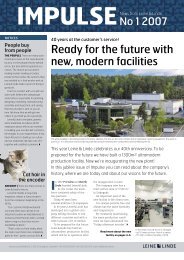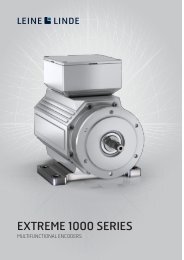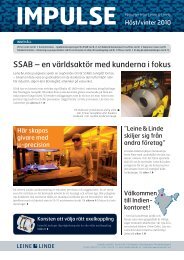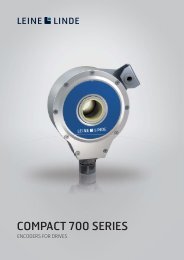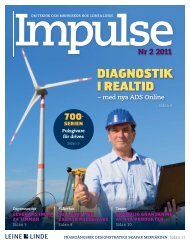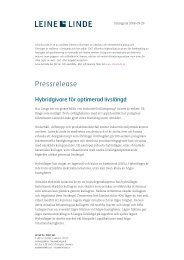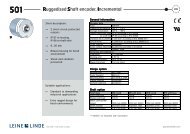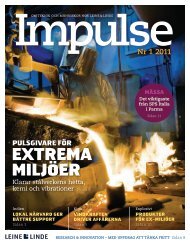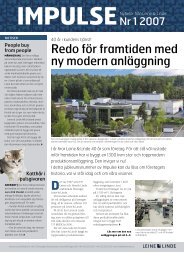Impulse no. 1 – 2010 (PDF) - Leine & Linde
Impulse no. 1 – 2010 (PDF) - Leine & Linde
Impulse no. 1 – 2010 (PDF) - Leine & Linde
Create successful ePaper yourself
Turn your PDF publications into a flip-book with our unique Google optimized e-Paper software.
Precision and accuracy are keywords<br />
Words such as exposure, pattern and developing make you think of photographers and developing<br />
labs, but they are also used by <strong>Leine</strong> & <strong>Linde</strong>’s optics department. Cleanness, quality and accuracy are<br />
required when critical components for pulse encoders are manufactured with micrometre precision.<br />
For an encoder to work, a code disc and<br />
a reference pattern are needed. Once the<br />
two components have been produced and<br />
installed with micrometre precision in<br />
an encoder, an LED can send a beam of<br />
light through them. Depending on what<br />
the pattern looks like and how fast the<br />
encoder shaft is rotating, light pulses are<br />
created and<br />
then converted<br />
into electrical<br />
pulses. It<br />
is these electrical<br />
pulses<br />
that are used<br />
to measure<br />
the speed or<br />
position of the<br />
pulse encoder.<br />
”On Time is a key concept for this department.<br />
The customer must get their product<br />
when they want it,” explains Resadija<br />
Salju<strong>no</strong>vic at the optics department. In<br />
this article we follow Resadija as she<br />
shows us round the production process<br />
that is central to <strong>Leine</strong> & <strong>Linde</strong>’s pulse<br />
encoders.<br />
<strong>Leine</strong> & <strong>Linde</strong> manufacture on demand<br />
from customers and do <strong>no</strong>t keep stocks<br />
of code discs. This means that planning<br />
is crucial, as all line counts between 1<br />
and 10,000 can be manufactured, even in<br />
small batches.<br />
Once the daily planning is finished, the<br />
work list for the day is printed out, with<br />
information on which variants of code<br />
discs are to be produced. They are made<br />
of either glass or plastic material, using<br />
special exposure equipment developed<br />
in-house. An original pattern is used in<br />
the manufacturing process, and it is the<br />
appearance of the original pattern that is<br />
copied onto the actual code disc.<br />
As the entire work process is extremely<br />
sensitive to dirt particles, all work is<br />
performed in a cleanroom.<br />
After exposure, the code disc undergoes<br />
a development process in order to<br />
develop the pattern copied during the exposure<br />
process. Developing is performed<br />
using an automated machine that lowers<br />
the code discs into various tanks containing<br />
developer and water.<br />
It is important that there are <strong>no</strong> spots<br />
left on the code discs from water or<br />
chemicals. So the machine does <strong>no</strong>t just<br />
develop the code discs; it also washes<br />
and dries them.<br />
”It’s like spots being left on a glass<br />
after it has been washed. There must be<br />
absolutely <strong>no</strong> spots like that on the code<br />
discs, because that could disrupt the<br />
pulse encoder’s function,” Resadija explains.<br />
Once developing is complete, the code<br />
disc has been given its special pattern<br />
and is ready for inspection.<br />
”Here it’s important to be extremely<br />
accurate, as the slightest error in the<br />
pattern can cause errors that lead to the<br />
finished pulse encoder <strong>no</strong>t working properly.<br />
It is partly a visual assessment of<br />
results, which demands skilled and experienced<br />
staff. In addition, all code discs<br />
are checked in an automatic system for<br />
their optic signal quality. Therefore, accuracy<br />
and quality are two keywords for the<br />
optics department,” Resadija says.<br />
After the code disc has been made a<br />
reference pattern is also required so that<br />
the finished pulse encoder will have the<br />
right function. The reference pattern<br />
is developed on a piece of glass that is<br />
glued firmly inside the pulse encoder.<br />
This gluing is performed by a gluing robot,<br />
and once it is finished the reference<br />
pattern is exposed on the piece of glass. It<br />
is extremely important for the reference<br />
pattern to be perfectly straight so that it<br />
can function correctly with the code disc.<br />
The piece of glass with the reference pattern<br />
undergoes the same process as the<br />
code disc, with exposure, developing and<br />
inspection.<br />
”Just as in the code disc work, there<br />
is a visual assessment in the inspection.<br />
A skilled and experienced eye checks<br />
whether there are any errors in the pattern.<br />
No quality without accuracy,” explains<br />
Resadija.<br />
Finally the code disc and reference pattern<br />
are installed in the encoder. Here too<br />
precision is a keyword. The code disc is<br />
centred on the encoder shaft and if this<br />
is <strong>no</strong>t done properly there is an accuracy<br />
error.<br />
Using special equipment, Resadija<br />
centres the code disc in its correct position<br />
on the shaft, extremely precise work.<br />
The maximum permitted deviation from<br />
the <strong>no</strong>minal position is 4-8 micrometres.<br />
By way of comparison, a single hair is<br />
around 50-70 micrometres thick.<br />
When the centring work is finished,<br />
the glue holding the code disc to the<br />
encoder shaft is hardened using UV light,<br />
and the department’s work is done. The<br />
finished robust optic module then moves<br />
to final assembly, where the complete<br />
encoder is assembled. <br />
4



